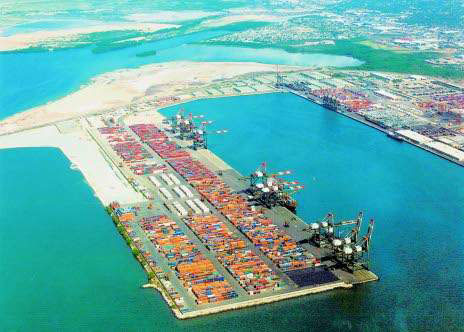(Jamaica Observer) The US$452-million port modernisation project is moving towards completion in Kingston, and it is already remaking Jamaica’s major port.
The Inter-American Development Bank (IDB), based in Washington DC, is providing two loans, amounting to US $215 million, while China Infrastructure Fund has given a loan commitment of US$50 million to Kingston Freeport Terminal Limited (KFTL) for the project to modernise the port of Kingston. KFTL operates Kingston Container Terminal (KCT) under a 30-year lease concession to finance, expand, operate and maintain the port, which is one of the largest container and trans-shipment ports in the Caribbean.
The project is being executed in three phases of which Phase 1 is completed while Phase 2, which is almost complete, has already transformed the port of Kingston through a number of land and offshore developments. Phase 3 is about to begin.
Phase 1 consists of deepening the channel, turning circle and quays to allow access by 14.2 m draft vessels; and within six years, capacity optimisation from 2.8 million 20-foot equivalent units (TEU) to 3.2 million TEU, while Phase 2 is increasing the draft to allow access by 15.5 m draft vessels. TEU is an inexact unit of cargo capacity often used to describe the capacity of container ships and container terminals. Phase 3 will see the construction of a new berth in order to increase KCT’s capacity to 4.5 million TEU.
The objective of the initial programme (Phases 1 and 2) is to increase the capacity of the port such that it will be able to accommodate the largest vessels transiting the expanded Panama Canal.
This goal has been achieved by: construction work, which increases the capacity of the quays at the berths to allow larger vessels; by dredging the shipping channel for greater draft; and increasing the stacking yard capacity through new equipment and operational changes.
The project includes equipment and infrastructure upgrades, specifically the south existing quays — the ship turning circle, plus the dredging for new vessel draft requirements .
The quays have been refurbished and strengthened. Out of the total 2400 m length, a subset of 1200 m of the quays will be capable of accommodating the New Panamax vessels. The terminal container yard will, at the end of the process, have a capacity of 102 hectares.
To increase terminal efficiency and capacity to 3.2 million TEU per year, the equipment upgrades include the purchase of four new cranes to make a total of 18 quay cranes and 64 straddle carriers. Additional quay refurbishment and strengthening have been completed.
Several existing cranes have been decommissioned and newer cranes commissioned into service. In Phase 2 the dredging works will deepen the realigned inner channel from the Phase 1 depth of 15.60 m to 17.0 m, to allow 12,600 TEU vessels with a draft of 15.5 m clearance for safe sailing conditions all the way to the swing basin. The dredging sediment quantity involved is in the range of 5.0 million m3. The dredging quantity involved is approximately 2.2 million m3. From the end of the ship’s channel into the eastern channel, the seaward areas of the outer harbour and the east channel will be more exposed to swell to deeper draft vessels (15.5 m in Phase 2 versus 14.2 m in Phase 1).
The total amount of sediment to be removed from east channel is estimated at 250,000 m3. As with Phase 1, there will be some specific outcrops that will need to be removed to achieve the desired depth, but these will not include previously anticipated removal of parts of Rackhams and Gun Cay.
Narrowing of the area adjacent to the harbour side of the causeway inlet/outlet could result in increased current velocities, eddy currents, sediment transport, freshwater plumes and changes to the hydrodynamics of the harbour.
However, due to the potential impact on flows in and out of Hunts Bay this activity has been removed from the project and may be considered for Phase 3, but only after additional evaluation of design options to mitigate these impacts.


